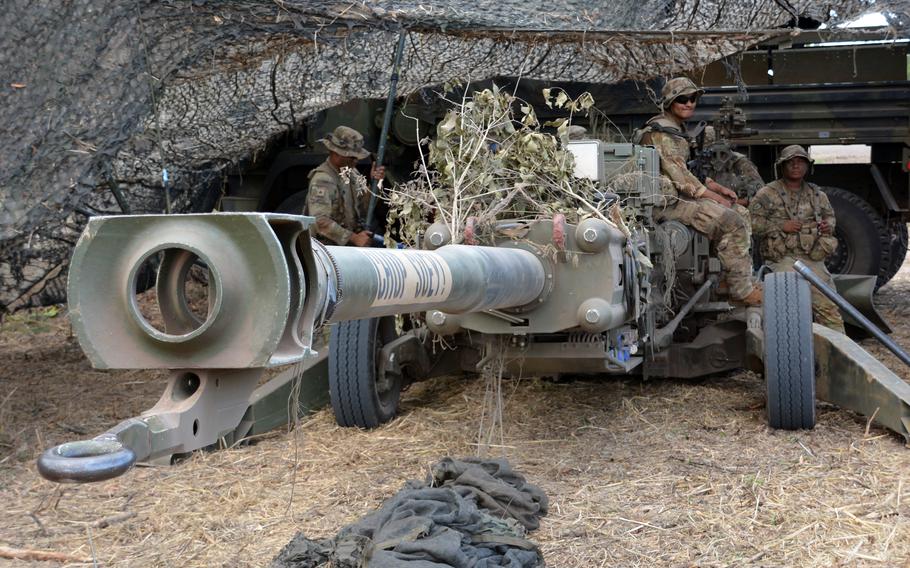
Artillerymen with the 25th Infantry Division man an M777 howitzer near the airstrip at Dillingham Airfield in Oahu, Hawaii, on Nov. 1. (Wyatt Olson/Stars and Stripes)
DILLINGHAM AIRFIELD, Hawaii — A massive, 10-day Army exercise in Hawaii brings together 5,100 U.S. soldiers, sailors, airmen and Marines, some of whom are expected to make a whirlwind roundtrip flight to Palau for a live-fire drill.
Joint Pacific Multinational Readiness Center exercise kicked off Wednesday in Hawaii, supported by U.S. Army Pacific and the 196th Infantry Brigade, both headquartered at Fort Shafter.
Now in its third year, the training rotates around one combat unit of the Hawaii-based 25th Infantry Division, focusing this time on the 3rd Brigade Infantry Combat Team.
The readiness center also operates a combat training center in Alaska, along with one that is deployable throughout the Indo-Pacific region.
The combat centers have personnel and equipment capable of providing realistic combat training of the kind soldiers would get at the Joint Readiness Training Center at Fort Johnson, La., or the National Training Center at Fort Irwin, Calif.
“We can outfit a training area with sensors, and we can bring soldiers in and put sensors on them,” Col. R.J. Garcia, 25th ID’s deputy commander for support, told reporters Wednesday during a tour of units deployed at Dillingham Airfield on Oahu’s North Shore.
All that data is examined by soldiers in tactical operations centers and command posts in spooling out the exercise scenarios, Garcia said.
“And we can really replicate the rigorous combat scenarios and situations we think we’ll see out here in the Pacific,” he said.
Hawaii to Palau
Among the training sites on Oahu are Bellows Air Force Station, Dillingham Army Airfield, Kahuku Training Area, Kawailoa Mountain Ranges, Helemanu Plantation and Schofield Barracks East and South Ranges.
On the Big Island of Hawaii, drills are happening at Pohakuloa Training Area, a 132,000-acre space operated by the Army but employed by all the services.
The combat scenarios are intended to replicate the kinds of battlefields, terrain and conditions the Army could face in a conflict in the Pacific.
Military personnel from Thailand, Indonesia, New Zealand and the United Kingdom are joining the exercise.
As a means of replicating large-scale combat scenarios, this month’s training includes a live-fire exercise on Palau in Micronesia.
“What Palau does is simulate the time, distance and decision-making across the Pacific,” Garcia said. “Really, what we’re trying to do is simulate, what does it take to put combat credible forces forward, and then what do they need to do their mission there.”
‘No right answer’
This portion of the field exercise will include several Air Force C-17 airlifters flying out of Wheeler Army Airfield on Oahu to deliver soldiers, the M142 High Mobility Artillery Rocket System, or HIMARS, and unmanned aerial systems to that island nation.
The targets will be about six miles offshore.
“The rocket propellant will be expended prior to impact and the munition, a missile body containing no radiation or other harmful materials, will sink to the ocean floor,” the Army said in a fact sheet about the training.
Several experiments are being conducted during the exercise, such as rapid water generation by which individual soldiers will “produce water without really an observable water source,” Garcia said.
Soldiers will also be experimenting with small unmanned aerial systems, he said.
Overall, the exercise is not designed against any particular threat, such as China, Garcia said.
Instead, the scenarios create “conditions that really have no right answer, so that we challenge the leadership, from soldier all the way to the highest levels of decision-making, so they’re more agile and ready to go, regardless of the adversary,” he said.